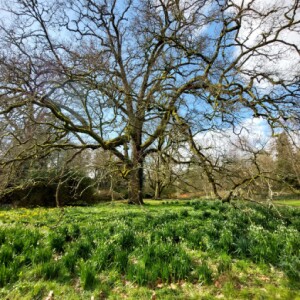Climate Change
Back blip
The morning started off foggy but, by lunchtime, this had given way to warm sunshine, so we were very pleased we had arranged to meet our friends L &P and M & P at Mottisfont Abbey (National Trust property ) in the Test Valley near Romsey. The house is currently hosting an interesting exhibition of W Heath Robinson's cartoons from WW1 and WW2, which are on loan from the Heath Robinson Museum in Pinner Middlesex.
After visiting the house we explored the extensive grounds which include a winter garden (first extra ), beautiful specimen trees (second extra) such as this fine oak tree surrounded by daffodil and Leucojum (Snowflake) flowers, and of course the famous walled rose garden, where the last of the winter pruning was taking place. The main blip is of a rather striking wicker snowdrop sculpture. Finally, we walked by a canalised arm of the River Test which flows along one edge of the estate, but the ground was too muddy and wet to venture far.
The font, filled by a series of springs ,after which the estate is named, was also very full and very muddy today. Often it is crystal clear.
This evening, we attended the monthly meeting of the local RSPB group. Tonight, however, the talk was about the state of Hampshire 's butterflies presented by the very knowledgeable and excellent speaker, Dr Andy Barker, from Butterfly Conservation.
In balmy Hampshire we are lucky enough to be home to most of the UK butterfly species ( 46 out of 61). Although many species are not nearly as abundant as they once were, due to habitat loss. it is not all bad news for us. With climate change we are more likely to see new species migrating across the English channel, such as Long- tailed Blue, Black Veined White, Large Tortoiseshell, Swallowtail, and Geranium Bronze. Already, Glanville Fritillary from the IOW are venturing across the Solent more often, and are beginning to colonise the Hampshire coast. Meanwhile, species which were only found in the south of England are beginning to migrate Northwards ( so Blippers in Scotland may be in for a treat and new source of blips before too long!).
Andy said that here, in Hampshire, if we see blue butterflies in our gardens, in October, especially around Everlasting Broad -leafed Pea plants ( Lathryus latifolius )they are very likely to be Long- tailed Blues,. for whose caterpillars this is a preferred food plant.
He also said that some species may not be quite as rare as supposed, such as the White Letter Hairstreak. The butterfly is rather elusive, as it flies around tree tops especially elms. However, they do fly down lower to feed on the flowers of privet and bramble, and it is worthwhile looking for their eggs and caterpillars on new buds on the lower branches of elms, especially suckers growing from dead elms.
He also addressed a concern of mine, which was the paucity of Small Tortoiseshell butterflies in the past few years. Indeed, I didn't see any last year. It may be explained by the increasing presence of a parasitic fly, Sturmia bella, which lays its eggs on nettles close to Small Tortoiseshell butterfly eggs and caterpillars. The fly's caterpillars then enter the butterfly's caterpillars and eat them from the inside out.
All in all, a most fascinating( if at times revolting !) informative evening.



Comments
Sign in or get an account to comment.


